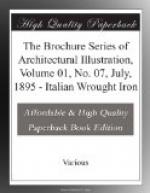In general, it can be said that everything, even including line drawings in pen and ink, can be reproduced by the half-tone processes, the quality of the plate depending upon the character of the original. Water-colors, monochrome drawings in wash, pencil drawings and any combinations of these, are reproducible, but with varying success. The same conditions which apply to line work also hold good to a considerable extent in the present case. A combination of vigorous black ink lines and lighter more delicate work put in with thinned or gray ink will in all probability be very unsatisfactory, as the chances of holding the relation between the two, or in fact of preserving the lighter lines at all, without over-emphasizing the darker portions, will not be very great. Delicate drawings can seldom be reproduced without giving a background tint all over, and this usually destroys the life and snap of the original. This is especially true of drawings upon reddish or yellowish paper, which on this account should be avoided if possible. It should be borne in mind that yellow and red photograph dark; and blue, light. This often makes a great difference of effect in the reproduction and sometimes makes it impossible to get satisfactory results at all, especially in delicate drawings.
Pencil drawings made with light lines will not reproduce well, as there is too little contrast in color between the lines and the paper; but sketches made with a soft pencil and strong contrasts frequently give surprisingly good results.
When drawings are to be made, especially for reproduction, the question of expense is often of importance. Plates made from pen drawings now cost about ten cents a square inch, while half-tone plates made of metal for printing on an ordinary printing press with type matter cost about twenty-five cents a square inch.
By using specially prepared process papers, which, if not sold by a local dealer in artists’ materials, can be had of Messrs. Wadsworth, Rowland & Co., or Frost & Adams, drawings can be made in pencil or black crayon which can be reproduced by the cheaper process, and will give excellent results. Considering the ease with which this work can be done and the satisfactory results obtained, it is surprising that it has not been more generally adopted. The only drawback to working upon this paper is the fact that no erasures or changes can be made without ruining the surface of the paper.
In connection with what has already been considered in relation to the reproduction of drawings, it may be well to refer to the making of plates from photographs. The selection of a good photograph is of the first importance. It should be brilliant, and with all the contrast of light and shade and as much detail as possible, for something is always lost in both these respects in the process of reproduction. A good plate can be made from a good photograph, but cannot from a bad one. The process is the same as that referred to above for the reproduction of wash drawings, etc., and the cost the same, about twenty-five cents a square inch. The half-tone plates in the Brochure series, made by The Blanchard & Watts Engraving Company, Boston, are good examples of first-class work of this description.




